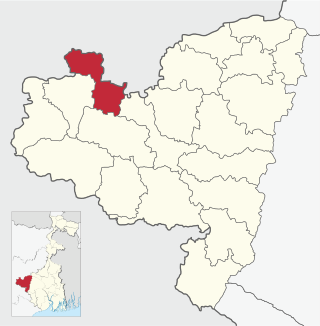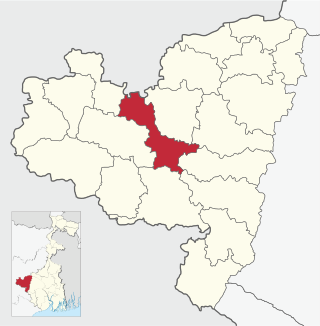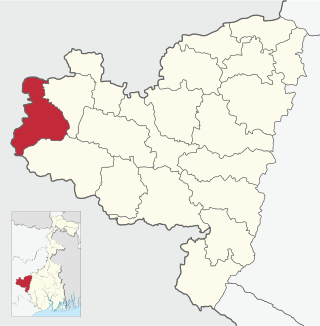
Joypur is a community development block that forms an administrative division in the Jhalda subdivision of the Purulia district in the Indian state of West Bengal.

Arsha is a community development block that forms an administrative division in the Purulia Sadar subdivision of the Purulia district in the Indian state of West Bengal.

Manbazar I is a community development block that forms an administrative division in the Manbazar subdivision of the Purulia district in the Indian state of West Bengal.

Puncha is a community development block that forms an administrative division in the Manbazar subdivision of the Purulia district in the Indian state of West Bengal.

Baghmundi is a community development block that forms an administrative division in the Jhalda subdivision of the Purulia district in the Indian state of West Bengal.
Bandwan is a census town in the Bandwan CD block in the Manbazar subdivision of the Purulia district in the state of West Bengal, India.

Ranibandh is a community development block that forms an administrative division in Khatra subdivision of Bankura district in the Indian state of West Bengal.
Manbazar is a census town in Manbazar I CD block in Manbazar subdivision of Purulia district in the state of West Bengal, India. The headquarters of Manbazar subdivision are located in Manbazar.

Manbazar II is a community development block that forms an administrative division in the Manbazar subdivision of the Purulia district in the Indian state of West Bengal.

Purulia I is a community development block that forms an administrative division in the Purulia Sadar subdivision of the Purulia district in the Indian state of West Bengal.

Purulia II is a community development block that forms an administrative division in the Purulia Sadar subdivision of the Purulia district in the Indian state of West Bengal.

Jhalda I is a community development block that forms an administrative division in the Jhalda subdivision of the Purulia district in the Indian state of West Bengal.

Jhalda II is a community development block that forms an administrative division in the Jhalda subdivision of the Purulia district in the Indian state of West Bengal.

Balarampur is a community development block that forms an administrative division in the Purulia Sadar subdivision of the Purulia district in the Indian state of West Bengal.

Barabazar is a community development block that forms an administrative division in the Manbazar subdivision of the Purulia district in the Indian state of West Bengal.

Raghunathpur I is a community development block that forms an administrative division in the Raghunathpur subdivision of the Purulia district in the Indian state of West Bengal.

Raghunathpur II is a community development block that forms an administrative division in the Raghunathpur subdivision of the Purulia district in the Indian state of West Bengal.

Neturia is a community development block that forms an administrative division in the Raghunathpur subdivision of the Purulia district in the Indian state of West Bengal.
Boro is a village, with a police station, in the Manbazar II CD block in the Manbazar subdivision of Purulia district in the state of West Bengal, India.
Puncha is a village, with a police station, and a gram panchayat in the Puncha CD block in the Manbazar subdivision of the Purulia district in the state of West Bengal, India.

















